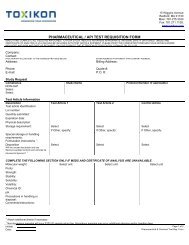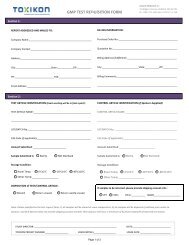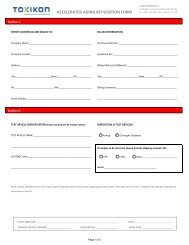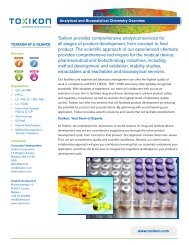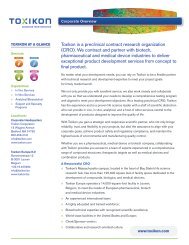Medical Device Testing Guide - Toxikon Corporation
Medical Device Testing Guide - Toxikon Corporation
Medical Device Testing Guide - Toxikon Corporation
Create successful ePaper yourself
Turn your PDF publications into a flip-book with our unique Google optimized e-Paper software.
RS06-3<br />
BI Strip Population Verification-Sample size: based on lot size<br />
Rev. May 2010<br />
The microbial population recovery from a biological indicator is determined via a population verification test. Each BI strip is<br />
aseptically transferred into 100 mL of chilled USP Sterile Water for Injection (SWFI) and homogenized. At the end of<br />
homogenization, an additional 5 mL of chilled SWFI is added. Based upon the label claim population, appropriate dilutions<br />
are prepared to yield 30-300 CFU per plate. 1 mL of each dilution is pour plated, in duplicate, on Trypticase Soy Agar (TSA)<br />
and incubated at 30-35 °C for up to 4 days. A standard plate count is utilized for verification of spore population. This test is<br />
routinely performed on incoming BI shipments to verify that the population meets specification before use. At least three BIs<br />
should be tested and the percent recoveries of the Label Claim Populations are reported.<br />
Note: The identification of the BI organism and expected titer needs to be provided by Sponsor/manufacturer.<br />
References: USP 31, NF 26, 2008. Biological Indicators Resistance Performance Tests<br />
BACTERIAL ENDOTOXIN (LAL) TESTING<br />
Purpose: The Limulus Amebocyte Lysate (LAL) test is an in vitro assay used for detection and quantitation of bacterial<br />
endotoxin. LAL is an aqueous extract of the blood cells of horseshoe crabs which forms a clot or change in color, depending<br />
on the technique, in the presence of bacterial endotoxin. Validated test methods include both the gel clot and chromogenic<br />
methods. Inhibition/Enhancement testing is performed prior to routine LAL testing to demonstrate validity of the LAL test.<br />
RL01-1<br />
RL01-2<br />
Inhibition and Enhancement <strong>Testing</strong>, Gel Clot Method-Sample size: Units from 3 lots<br />
This test involves testing a liquid sample or a sample extract with Limulus Amebocyte Lysate (LAL). The liquid sample or<br />
extract is spiked with varying concentrations of Control Standard Endotoxin (CSE) in quadruplicate. LAL is then added to<br />
each tube. All tubes are incubated in a 37 1 C heat block for 60 2 minutes. After incubation all tubes are examined for<br />
agglutination. The test samples are compared to a standard series of Control Standard Endotoxin (CSE) dilutions.<br />
Approximate turnaround time is one week<br />
Inhibition and Enhancement <strong>Testing</strong>, LAL Kinetic Chromogenic Method-Sample needed: Units from 3 lots<br />
The test article is reconstituted in USP Sterile Water for Injection (SWFI) and assayed in duplicate at various concentrations. A<br />
standard curve of endotoxin is prepared with concentrations of 0.005, 0.05, 0.5, and 5 EU/mL. LAL Reagent (endotoxinfree)<br />
water and SWFI serve as the negative controls. The microtiter plate is preincubated in the plate reader at 37 1 C for<br />
10 minutes. After incubation, LAL (0.1 mL) is added to each well and the absorbance of each well at 405 nm is read every<br />
150 seconds for a total of 40 data points or until the concentration reaches 0.2 absorbance units. The Kinetic QCL reader uses the<br />
initial reading of each well as its own blank. The absolute value of the correlation coefficient (r) must be 0.980 in order for the<br />
test to be valid.<br />
Approximate turnaround time is one week<br />
RL02-1<br />
RL02-2<br />
Gel Clot Limulus Amebocyte Lysate Test-Sample needed: Lot size dependent<br />
The endpoints of these dilutions are used to calculate the amount of endotoxin present in the sample. All tests are performed at<br />
least in duplicate. A positive product control using the sample and negative control using non-pyrogenic water are also<br />
performed. The endotoxin limit for devices used intrathecally (cerebrospinal fluid contact) is 2.15 EU/device (Endotoxin<br />
Units/device). The limit for other medical devices is 20.0 EU/device. For drugs and liquids, refer to the LAL <strong>Guide</strong>line<br />
published by US FDA (December 1987).<br />
Approximate turnaround time is one week<br />
Kinetic Chromogenic Limulus Amebocyte Lysate Test-Sample needed: Lot size dependent<br />
The test articles are either immersed in or flushed with USP Sterile Water for Injection (SWFI) at room temperature for<br />
60 2 minutes. Test article extracts are assayed in duplicate at the neat concentration. A standard curve of endotoxin is prepared<br />
with concentrations of 0.005, 0.05, 0.5, and 5 EU/mL. A positive product control (PPC) is prepared containing 0.09 mL of the test<br />
article and 0.01 mL of a 5 EU/mL endotoxin standard to give a final concentration of 0.5 EU/mL. LAL Reagent (endotoxinfree)<br />
water and SWFI serve as the negative controls. The microtiter plate is pre-incubated in the plate reader at 37 1 C for 10<br />
minutes. After incubation, LAL (0.1 mL) was added to each well and the absorbance of each well at 405 nm was read every<br />
150 seconds for a total of 40 data points or until the concentration reaches 0.2 absorbance units. The Kinetic QCL reader uses the<br />
initial reading of each well as its own blank. The absolute value of the correlation coefficient (r) must be 0.980 in order for the<br />
test to be valid.<br />
Approximate turnaround time is one week<br />
15 Wiggins Avenue, Bedford, MA 01730 781.275.3330 www.toxikon.com



